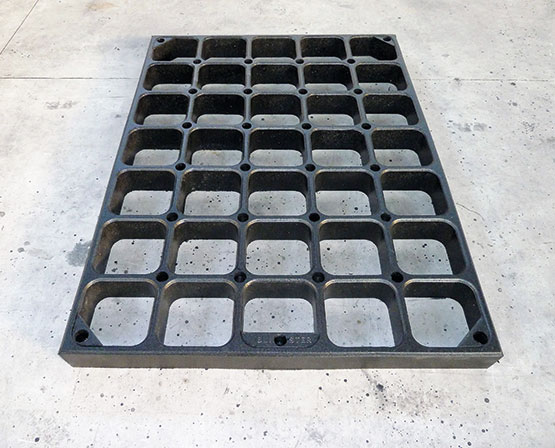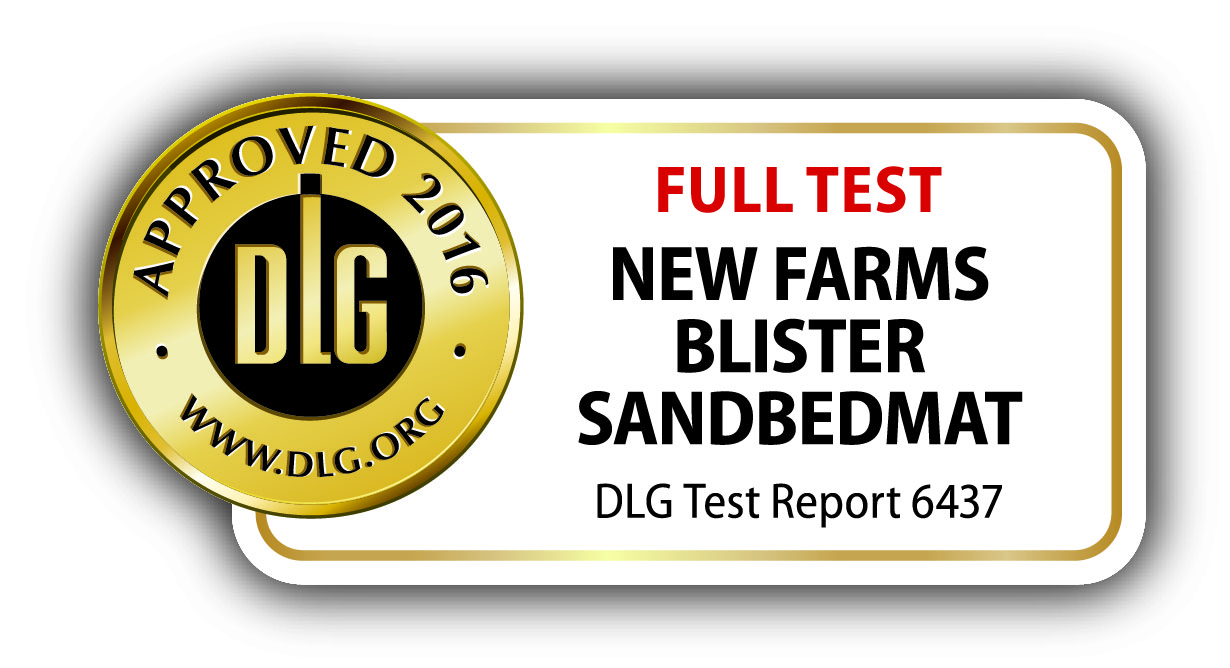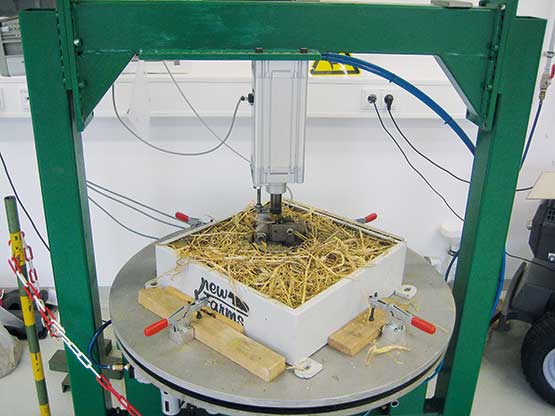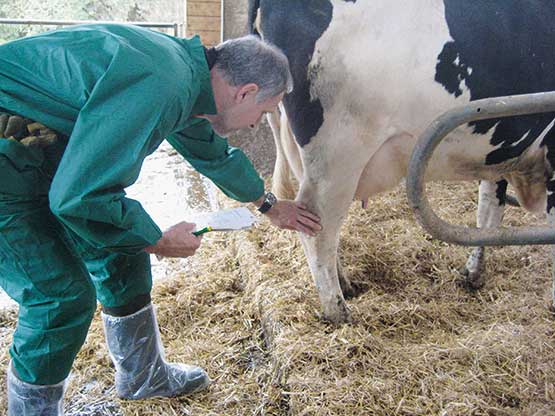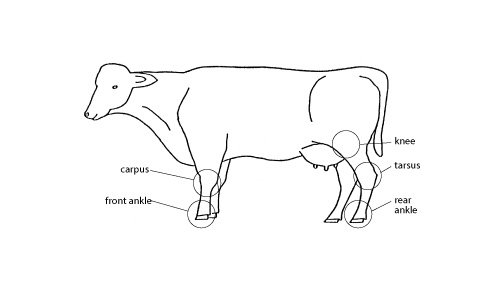New Farms s.r.l. Blister Sandbedmat (DLG-FULL-TEST)
DLG-APPROVED: Full Test
A quality mark “DLG-APPROVED FULL TEST“ is awarded to agricultural products which passed DLG’s comprehensive usability test according to independent and approved evaluation criteria. The product’s most important criteria from the farmer’s point of view are evaluated during this test. The test includes investigations on test benches and under various operating conditions and furthermore, the tested item must prove itself during a practical testing on a farm. The test conditions and procedures are fixed in a test framework which is developed by an independent test commission and adjusted regularly according to accepted rules of engineering as well as to latest scientific and agricultural knowledge and requirements. The successful test concludes with the publication of a test report as well as with the award of the quality mark, being valid for five years after the award.
The DLG-APPROVED full test included technical measurements in the lab of the DLG Test Center and practical examinations, behaviour observations, joint evaluation and a survey on agricultural farms. On test rigs in the lab the deformation, the slip resisitance and the acid resistance were measured and a permanent tread load test was carried out.
The test was based on the DLG Testing Framework for elastic stable flooring, as of April 2010.
Assessment – Brief Summary
The Blister sandbedmat tested here, a system for building a resting area in cubicles in cubicle houses, was tested as a system with a rubbermat filled with sand and organic litter with regard to durability and comfort properties. On the practical farms the installation and the dimensional stability were evaluated and behaviour observations and a joint evaluation were executed. The joint evaluation was clearly better than the standard.
Table 1: Overview of results
| Test criteria | Test result | Evaluation* |
|---|---|---|
| Suitability | as an building block to build an elastic floor cover in the resting area in cubicle houses. | |
| Technical criteria | ||
| Test rig measurements | ||
| Permanent tread load | no lasting deformation | + + |
| no noticeable wear | + | |
| Acid resistance** | ||
| Feed acid mixture | resistant | ◯ |
| Uric acid | resistant | + |
| Sulfurous acid | resistant | + |
| Ammonia solution | resistant | + |
| Disinfection liquid | resistant | ◯ |
| Peracetic acid | resistant | ◯ |
| Dimensional stability | ||
| no significant alteration in length or width | + | |
| noticeable deformation was not observed | + | |
| Handling, installation | ||
| Installation by the owner | maintainable work | ◯ |
| Installation instructions | detailed and understandable | + |
| Maintenance | continous spreading of litter necassarry | ◯ |
| Self cleaning | good | + |
| Daily cleaning | does not cause any difficulties | + |
| resting area very dry and the cows are clean | + + | |
| Warranty, recycling | ||
| Sandbedmat | 5 Years declining | |
| recycling concept | + | |
| Animal related criteria | ||
| Behavioral observations | no deviation from specific behaviour noticeable | + |
| good footedness of the cows | + | |
| Joint evaluation | 94,0 % without any pathological result | + + |
| Deformability and elasticity | with enough litter good deformability and elasticity | + |
| Toxicological safety | confirmed by the manufacturer | ◯ |
The Product
Blister sandbedmat

Description and Technical Data
The Blister sandbedmat tested here, is a system for building a lying area in cubicle barns for cows and cattle.
Black Rubber sandbedmat with 35 quadratic chambers ca. 20 cm x 20 cm, which are filled with sand. The surface of the sandbedmat should be interspersed with ca. 5 cm straw litter.
The sanbedmat are fixed with 13 screws plus disks and dowel on the anchoring supports on the floor.
Table 2: Technical Data
| Length | 154 cm |
| width | 114 cm |
| high | 11 cm |
| Weight | 50 kg each mat |
| Shore A | 75 |
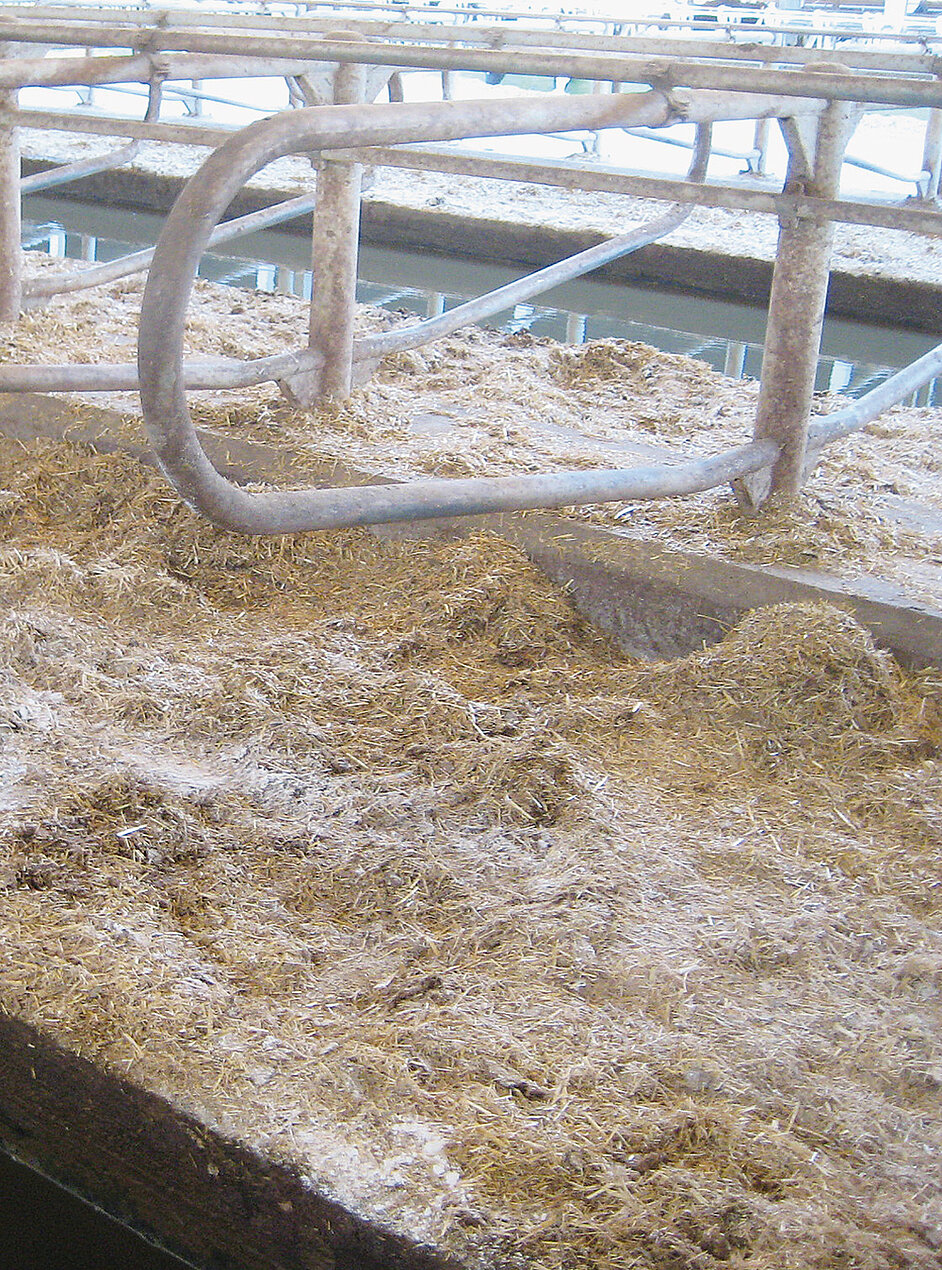
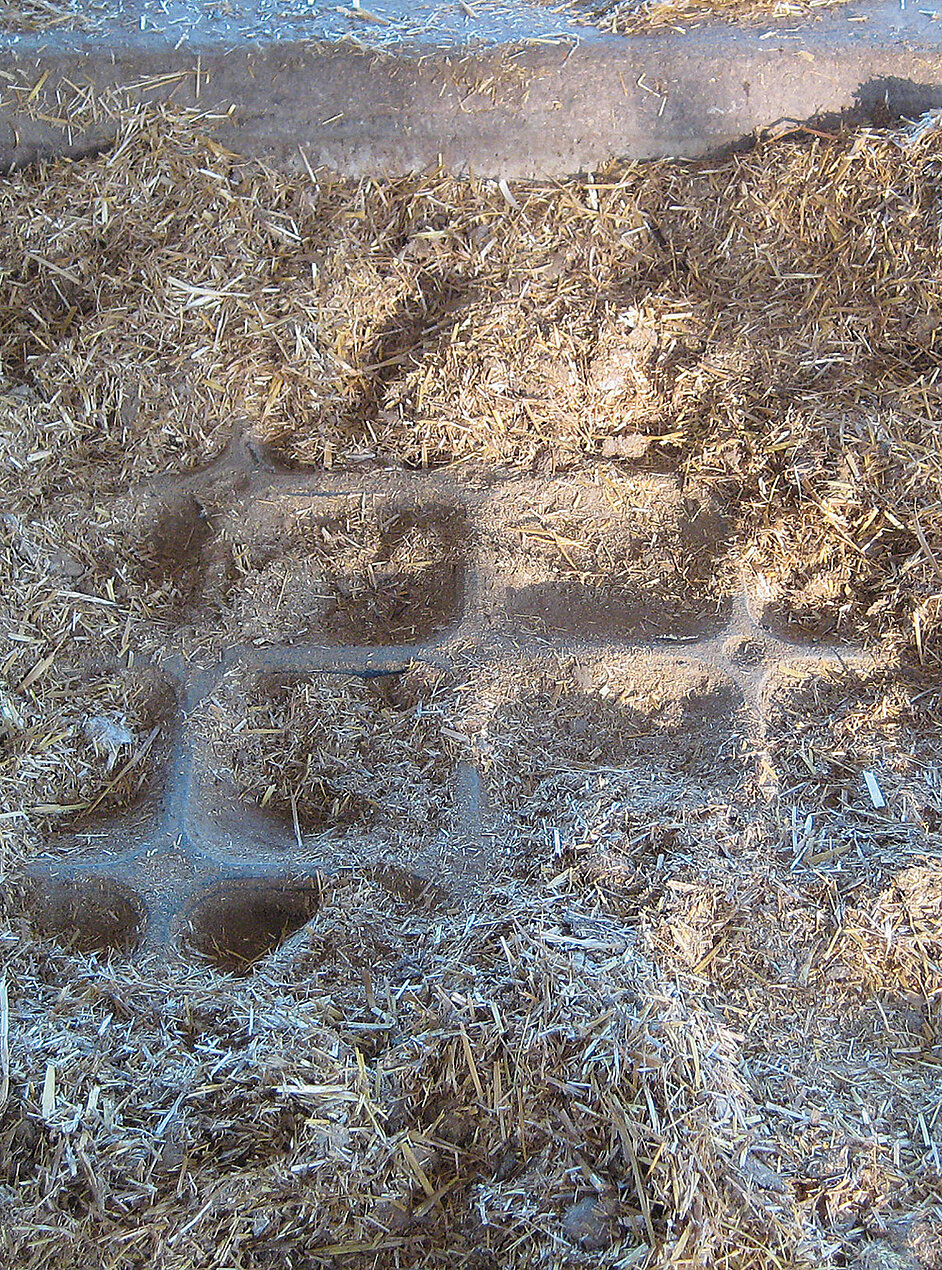
The Method
Suitability
The suitability and the range of use of the system for building a lying area in cubicle barns were evaluated by a practice-oriented focus.
Survey
A survey, by asking owners which had the equal system for building a lying area in cubicle barns for min. 3 month, was carried out to verify the test results.
Technical criteria
Wear resistance, durability, ageing and Permanent tread load
The permanent tread load is measured on a test stand with a round steel foot in the standard test programme with 100,000 alternating loads at 10,000 N (corresponding to approx. 1,000 kg). The steel foot is adapted to the natural conditions as an “artificial cow foot”. The foot has a diameter of 105 mm and therefore a contact area of 75 cm²; the carrying edge of the hoof is simulated by a 5 mm wide ring on the periphery of the sole that projects 1 mm above the rest of the surface.
Acid resistance
A permanent dipping test in accordance to DIN EN ISO 175:2000 (performance of synthetic material against liquid chemicals) was carried out.
Test samples (size 30 x 30 mm) were completely dipped into different test liquids for 24 hours and 28 days (room temperature 20° Celsius). In the 28 days test the liquids were changed weekly. After the 28 days the samples were washed with distillate water and dried for 24 hours. Before and after the dipping the weight, the dimensions and the shore hardness (shore A) of the test samples were measured. Additional visual evaluation was done for alterations like colour changing, swelling, destruction or crystallisation. All samples were evaluated in comparison to the standard water.
Dimensional stability
The dimensional stability (formation of hollows) of the system was evaluated after instalation in accordance to the installation instructions from the manufacturer. Additional was evaluated if alteration in length or width or deformation of the sandbedmat was noticeable.
Handling, installation and maintenance
The handling, installation and necassary maintenance of the sandbedmat were evaluated related to practice.
Cleaning
The cleaning of the sandbedmat was evaluated related to practice.
Guarantee and recycling
The manufacturer is required to state if and how long a guarantee is granted and which is included in the guarantee. The manufacturer is required to state if there is an recycling concept for the sandbedmat.
Animal-related criteria
Animal observations
During the practical use behaviour observations were executed by direct observations. It was observed if there was some deviation from specific behaviour noticeable (e.g. typical movement process getting up and lying down, lying positions) which would have to be attributed to the sandbedmat were determined. The direct observation of 20 getting-up processes each on two farms did not show any deviation from the normal movement process. In addition, no deviations from specific behavioural patterns To evaluated the footedness of the cows direct observation of 20 getting-up processes each on two farms were carried out.
Joint evaluation
On three farms which had installed only the tested sandbedmat, cows were examined for externally visible damage in the joint area as of the second third of lactation (joint evaluation). Evaluation comprised the left and right half of the body and focused on the 10 spots exposed during resting (cf. figure 7).
Joint evaluation was always carried out by the same person at the end of the winter feeding period. The results were classified according to the following scheme (table 3).
Table 3: Classification of the joint evaluation
| Result | Classification |
| without any particular result | no alterations |
| hairless spots < 2 cm | small alterations |
| hairless spots > 2 cm | small alterations |
| skin abrasions < 2 cm | medium alterations |
| skin abrasions > 2 cm | medium alterations |
| increased circumference in the bursal area, covered | medium alterations |
| increased circumference in the bursal area, open | great alterations |
| joint participation | great alterations |
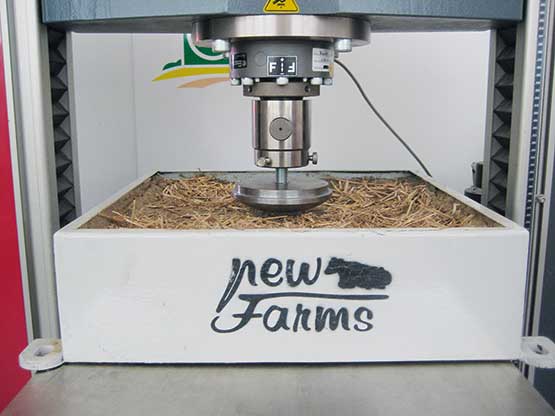
Deformability and elasticity
The deformability is measured in new condition and following permanent tread load using ball penetration tests with a calotte (r = 120 mm) and a penetration force of 2,000 N (corresponding to approx. 200 kg).
Toxicological safety
The manufacturer has to confirm the toxicological safety of the sandbedmat.
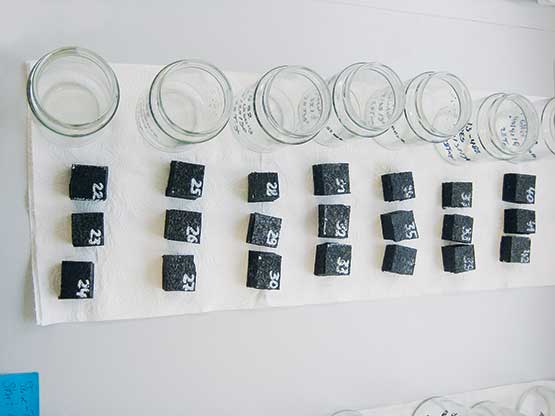
The Test Results in Detail
Technical criteria
Wear resistance, durability and ageing
Permanent tread load
After exposure to a permanent tread load exerted by a round steel foot (contact area 75 cm²) on a test stand and 100.000 alternating loads of 10.000 N (corresponding to ca. 1000 kg), no noticeable wear at the cross link of the sandbedmat was determined. No lasting deformation could be observed.
Acid resistance
The sandbedmat was limited resistant against feed acid mixture, barn disinfection liquid and peracetic acid. The sandbedmat was resistant against the other test liquids.
By this liquids the differences in weight, thickness and Shore A hardness between the acid treated and not acid treated samples were minor and lay in the range of water as standard.
Against the used liquids the rubber mat seems to be satisfactory suited for the described use.
Table 4: Test liquids and results – acid resistance
| Test liquid | Concentration | Result after 24 hours residence time | Result after 28 days residence time | Evaluation |
| Feed acid mixture | concentrate, pH 2 | no changing | test sample with more than 25 % increase of weight | limited resistant |
| Excrement acids | ||||
| Uric acid | saturated urea solution (0,4%) | no changing | no changing | resistant |
| Sulfurous acid | 5-6% SO2 | no changing | no changing | resistant |
| Ammonia solution | 32 % solution | no changing | resistant | |
| Disinfection liquid |
h Barn Disinfection liquid | 2 %-solution of a product with formic acid and glyoxyl acid| no changing | test sample with more than 25 % increase of weight | limited resistant Peracetic acid |3000 ppm | no changing |test sample with more than 25 % increase of weight| limited resistant |
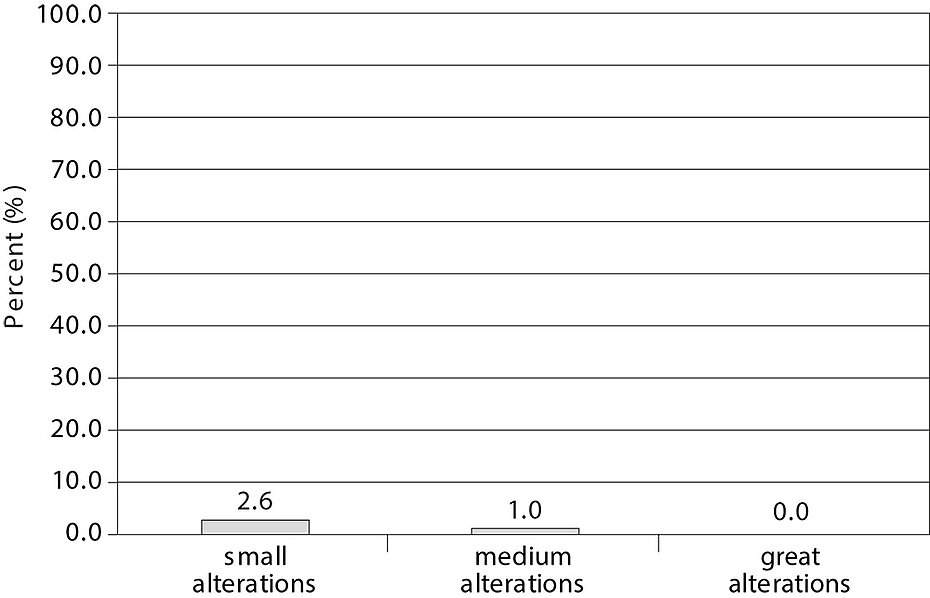
Dimensional stability
During the test period of 11 month, a noticeable alteration of length and width did not occur in practice after proper installation. Deformation (formation of craters and channels) was not observed.
Handling, installation
The installation instructions are detailed and understandable. The installation is possible with maintainable work of the farmer. Installation requires min. two persons. The sanbedmat are fixed with 13 screws plus disks and dowel on the anchoring supports on the floor. As maintenance continous intersperse of litter is necassary.
Cleaning
The self cleaning effect is good and the daily cleaning of the surface does not cause any difficulties. With continous intersperse of litter the resting areas are very dry and the cows are clean.
Warranty and recycling
According to its warranty conditions, the registering company grants a warranty of 5 years declining for the sandbedmat. The registering company has an recycling concept for the sandbedmat. The clean sandbedmats can send on own costs to the manufacturer. A written agreement with the manufacturer is recommended.
Animal-related criteria
Behavioural observations
During the practical use, behavioural observations in the form of video- and direct observations were carried out. The direct observation of 20 getting-up processes each on two farms did not show any deviation from the normal movement process. In addition, no deviations from specific behavioural patterns (e.g. typical movement process getting up and lying down, lying positions) which would have to be attributed to the floor cover were determined. The footedness of the cows on the sandbedmat was good, no slipping of the cows was observed.
Joint evaluation
On three farms which had installed only the tested cow mattress, a total of 105 cows were examined for externally visible damage in the joint area as of the second third of lactation (joint evaluation). Evaluation comprised the left and right half of the body and focused on the 10 spots exposed during resting (cf. figure 7). Joint evaluation was always carried out by the same person at the end of the winter feeding period.
In two farms straw litter was used on the sandbedmat. On one farm pellets made of husk were used as litter.
The percentage of the results found in the 105 animals examined is shown in figure 10. 96.4 % of the spots evaluated did not show any pathological result. Great alterations, like increased circumference in the bursal area, open joint participation were not found.
Small alterations, such as hairless spots were found at 2.6 % of the spots evaluated. At 1.0 % of the spots evaluated medium alterations, such as skin abrasions and increased circumference in the bursal area (covered) at the joints were found. The pathological results determined were mainly found in the tarsal joint. Only in a few cases were pathological results found in the ankles ort the carpal joint.
Deformability and elasticity
In ball impression tests in new condition with a calotte (r=120 mm) the deformation was measured on three different places on the sandbedmat.
The penetration depth at the sandfilling was 19.0 mm, on the link of the sandbedmat 11.5 mm and on the cross link of the sandbedmat 4.7 mm. The calculated bearing pressure were 14.0 to 56.4 N/cm². Elasticity was measured after a permanent tread load exerted by the steel foot to the cross link of the sandbedmat. After the endurance test, the penetration depth increased from 4.7 to 5.3 mm. This means that deformability and elasticity increased little.
Suitability
The sandbedmat is suitable as an elastic floor cover in resting area of cubicles in cubicle houses. For a good function the sandbedmat has to be filled with sand and the sand must be compacted.
Additional the sandfilled sandbedmat has to be coverd with ca. 5 cm suitable litter (e.g. chaff straw). The litter has to be added continous.
Survey
A survey among 14 farms, which have been using the sandbedmat up to 8 years, confirmed the experiences of the test. On the farms, a total of 1807 cubicles were equipped with the sandbedmat. On 12 farms the sandbedmat was installed by the farmer. 11 of these farmers stated that installation was easy and did not require any practice.
On all of the farms the cubicles were accepted well by the animals and there were no problems with acclimatization of the cows. In all of the farms no slipping of the animals was observed. All of the farmers observed a reduction of joint alterations. In no farm damage on the sandbedmat was observed. The sandbedmat was evaluated good by one farmer and very good 13 farmers. All farmers would purchase the sandbedmat again if necessary.
Summary
The utility value test included technical measurements on test rigs and practical tests with regard to durability and comfort properties of the New Farms sandbedmat as a system for building a lying area in cubicle barns for cows and cattle.
Test stand trial comprised tests of abrasion resistance (using an emery cloth), and the acid resistance.The tested New Farms sandbedmat met the requirements of the Testing Framework with respect to the investigated criteria.
Manufacturer and Applicant
New Farms s.r.l.,
Via Visano Nr. 2,
I-25010 Remedello (BS)
www.newfarms.it
Test performed by
DLG e.V.,
Testzentrum Technik und Betriebsmittel,
Max-Eyth-Weg 1,
64823 Groß-Umstadt
DLG test scope
Approved Full Test „for elastic stable flooring“
(version 04/2010)
Department
Animal Husbandry Technologies
DLG Expert Committee for animal welfare
Dr sc. agr. Christiane Müller, Trenthorst
Practical test
Schmidt GbR, 63549 Ronneburg
Agrargenossenschaft Seifhennersdorf e.G.,
2782 Seifhennersdorf
DLG Test Commission
Dr agr. Steffen Pache, Köllitsch
Dipl.-Ing. Andreas Pelzer, Bad Sassendorf
Alfons Baumeister, Bad Sassendorf
Reiner Schmidt, Ronneburg
Dipl.-Ing. agr. Klaus-Werner Wolf, Höchst
Dr med. vet./Dipl.-Ing. agr. Univ. Wilfried Wolter, Giessen
Head of Department
Graduate engineer. agr. Susanne Gäckler
Test engineer(s)
Dr. Harald Reubold *
* Author
Contact
DLG TestService GmbH - Groß-Umstadt location • Max-Eyth-Weg 1 64823 Groß-Umstadt Germany • Tel.: +49(0)69 24 788-611 • tech@DLG.org

